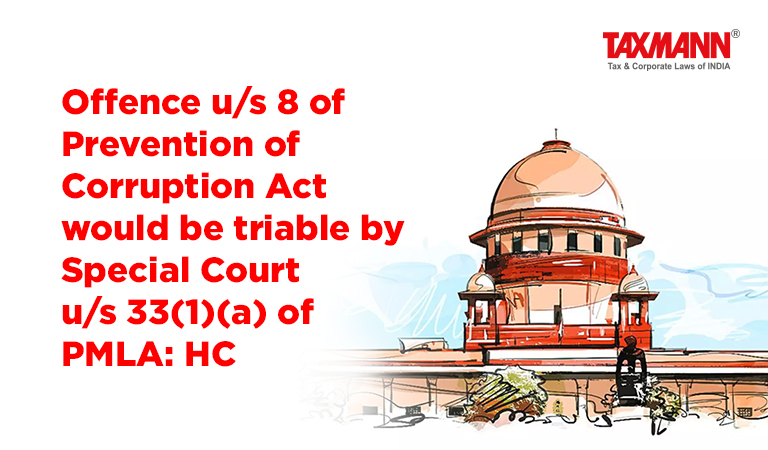Offence u/s 8 of Prevention of Corruption Act would be triable by Special Court u/s 33(1)(a) of PMLA: HC
- Blog|News|FEMA & Banking|
- 2 Min Read
- By Taxmann
- |
- Last Updated on 12 December, 2025

Case details: Upendra Rai v. Central Bureau of Investigation - [2021] 128 taxmann.com 28 (Delhi)
Judiciary and Counsel Details
-
- Vibhu Bakhru, J.
- Arjun Dewan, Arjun Mukherjee and Shahryar Khan, Advs. for the Petitioner
- Nikhil Goel, SPP, S.V. Raju, ASG Amit Mahajan, CGSC Sarica Raju, A. Venkatesh, Guntur Pramod Kumar and Kritagya Kumar Kait, Advs. for the Respondent
Facts of the Case
The impugned order was passed by Special Judge directing transfer of trial proceedings under Prevention of Corruption Act, 1988 (PC Act) to Special Court, Prevention of Money Laundering Act (PMLA).
The petitioner submitted that since Special Court, PMLA was not empowered to try cases for offences under PC Act, the impugned order transferring the case to such a court, which did not have jurisdiction to decide it, was patently erroneous and was liable to be set aside.
High Court Held
The HC found that PC Act and PMLA Act are both special statutes in their fields and both relate to different offences and none of the two enactments can be considered as general or special concerning other.
Further, clause (a) of section 44(1) of PMLA expressly provides that scheduled offence and an offence punishable under section 4 of PMLA shall be triable by Special Court constituted for an area in which offence has been committed.
Therefore, where the petitioner was being tried for an offence under section 8 of PC Act, pursuant to FIR, which was a scheduled offence, in terms of clause (a) of section 44(1) of PMLA, said the offence was triable by a Special Court, PMLA.
List of Cases Referred to
-
- P. Nallamal v. State [1999] 6 SCC 559 (para 10)
- Inspector of Police, CBI v. Asstt. Director, Directorate of Enforcement (PMLA) [Crl M.C. No. 2178 of 2019, dated 8-11-2019] (para 10)
- State of Haryana v. Raghubir Dayal [1995] 1 SCC 133 (para 11)
- Solidoire India Ltd. v. Fairgrowth Financial Services Ltd.[2001] 30 SCL 59 (para 12)
- Union of India v. G.M. Kokil 1984 Supp SCC 196 (para 21)
- Aswini Kumar Ghosh v. Arabinda Bose AIR 1952 SC 369 (para 22)
- KSL & Industries Ltd. v. Arihant Threads Ltd. [2011] 3 taxmann.com 50 (SC) (para 35)
- Jay Engg. Works Ltd. v. Industry Facilitation Council [2006] 8 SCC 677 (para 36)
- Bhoruka Steel Ltd. v. Fairgrowth Financial Services Ltd. [1997] 89 Comp. Cas 547 (SC) (para 42)
- Maharashtra Tubes Ltd. v. State Industrial and Investment Corpn. of Maharashtra Ltd. [1993] 2 SCC 144 (para 43)
- Bank of India v. Ketan Parekh [2009] 92 SCL 309 (SC) (para 45)
- S. Vanitha v. Dy. CIT, Bengaluru Urban District 2020 SCC OnLine SC 1023 (para 46)
Disclaimer: The content/information published on the website is only for general information of the user and shall not be construed as legal advice. While the Taxmann has exercised reasonable efforts to ensure the veracity of information/content published, Taxmann shall be under no liability in any manner whatsoever for incorrect information, if any.

Taxmann Publications has a dedicated in-house Research & Editorial Team. This team consists of a team of Chartered Accountants, Company Secretaries, and Lawyers. This team works under the guidance and supervision of editor-in-chief Mr Rakesh Bhargava.
The Research and Editorial Team is responsible for developing reliable and accurate content for the readers. The team follows the six-sigma approach to achieve the benchmark of zero error in its publications and research platforms. The team ensures that the following publication guidelines are thoroughly followed while developing the content:
- The statutory material is obtained only from the authorized and reliable sources
- All the latest developments in the judicial and legislative fields are covered
- Prepare the analytical write-ups on current, controversial, and important issues to help the readers to understand the concept and its implications
- Every content published by Taxmann is complete, accurate and lucid
- All evidence-based statements are supported with proper reference to Section, Circular No., Notification No. or citations
- The golden rules of grammar, style and consistency are thoroughly followed
- Font and size that’s easy to read and remain consistent across all imprint and digital publications are applied



 CA | CS | CMA
CA | CS | CMA
